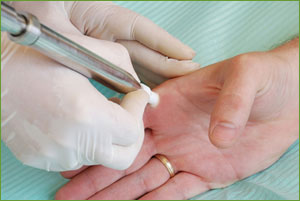Other Skin Cancer Treatments
Topical Chemotherapy
Topical chemotherapy is used in the treatment of non-carcinoma skin cancers that live only in the top layer of skin. It may also be used to treat actinic keratoses, which are lesions that are caused by years of sun damage to the skin. These lesions can develop into squamos cell carcinoma. These are treated with topical chemotherapy cremes that vary in strength and make-up depending upon the severity of the treatment area. A follow up appointment is required to verify that the chemotherapy is providing adequate treatment of the area.
Cryosurgery (freezing)
Cryosurgery is another treatment for non-melanoma skin cancers.Usually this treatment is used for actinic keratoses, but it may also be used when there are many lesions to be treated. Cryosurgery involves the application of liquid nitrogen via an aerosol spray to freeze and destroy the cancerous or pre cancerous cells. The treated area can take three to six weeks to heal. This type of treatment carries the minor risks of infection, scarring, and stinging pain during the procedure. There is a small chance of recurrence of the skin cancer following cryosurgery. A follow up appointment is recommended to ensure that the treatment was effective in removing the entire cancer.
Electrodesiccation and Curettage (burning)
This is another treatment option for non-melanoma skin cancers. A curette (sharp spoon shaped tool) is used to remove the tumor. Then, an electrode is used to destroy the surrounding tissue. The electric current stops bleeding and destroys cancerous cells around the edges of the wound. This process may be repeated one to three times and has a 95% success rate. This is a quick and simple method of removing skin cancers, but it has some additional risks over Mohs surgery. Because the borders of the treatment site are not checked after treatment, the surgeon is unable to determine if any cancerous cells remain. For this reason, a follow-up appointment withing six months is highly recommended. In addition, a sub optimal scar is left after healing is completed.
Surgical Excision
This is the most common treatment for melanoma skin cancers. When cancers are well-defined and not in a cosmetically sensitive area, they are simply removed surgically with a scalpel, and the wound is closed with sutures. This process requires the surgeon to remove extra tissue around the border of the visible tumor. Once removed, the tissue is sent to a pathologist to determine whether the borders are clear and contain no cancerous cells. If the borders do contain cancerous cells, a second procedure is required to remove the remaining cancer.






